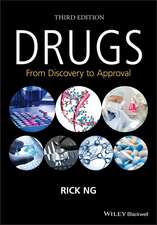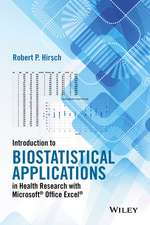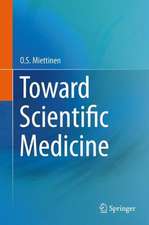Epidemiological Research: Terms and Concepts
Autor O. S. Miettinenen Limba Engleză Paperback – 17 oct 2014
This book is intended to serve as a handbook for whomever is, in whatever way, concerned with epidemiological or ‘meta-epidemiological’ clinical research. But besides this, it is also intended to serve as a textbook for students in introductory courses on ‘epidemiological’ research – to which end there is a suggested hierarchy of the concepts that might reasonably be covered.
| Toate formatele și edițiile | Preț | Express |
|---|---|---|
| Paperback (1) | 363.07 lei 6-8 săpt. | |
| SPRINGER NETHERLANDS – 17 oct 2014 | 363.07 lei 6-8 săpt. | |
| Hardback (1) | 370.21 lei 6-8 săpt. | |
| SPRINGER NETHERLANDS – 28 apr 2011 | 370.21 lei 6-8 săpt. |
Preț: 363.07 lei
Preț vechi: 382.18 lei
-5% Nou
Puncte Express: 545
Preț estimativ în valută:
69.47€ • 75.77$ • 58.58£
69.47€ • 75.77$ • 58.58£
Carte tipărită la comandă
Livrare economică 24 aprilie-08 mai
Preluare comenzi: 021 569.72.76
Specificații
ISBN-13: 9789401784368
ISBN-10: 9401784361
Pagini: 192
Ilustrații: XVI, 175 p.
Dimensiuni: 155 x 235 x 10 mm
Greutate: 0.28 kg
Ediția:2011
Editura: SPRINGER NETHERLANDS
Colecția Springer
Locul publicării:Dordrecht, Netherlands
ISBN-10: 9401784361
Pagini: 192
Ilustrații: XVI, 175 p.
Dimensiuni: 155 x 235 x 10 mm
Greutate: 0.28 kg
Ediția:2011
Editura: SPRINGER NETHERLANDS
Colecția Springer
Locul publicării:Dordrecht, Netherlands
Public țintă
Lower undergraduateCuprins
Preface.Introduction. Acknowledgements. PART I. MEDICINE, SCIENCE, AND STATISTICS. I – 1. Terms and Concepts of Medicine. I – 2. Terms and Concepts of Science. I – 3. Terms and Concepts of Statistics. PART II. EPIDEMIOLOGICAL RESEARCH PROPER. II – 1. Introduction. II – 2. Introductory Terms and Concepts. II – 3. Terms and Concepts of Objects of Study. II – 4. Terms and Concepts of Methods of Study. PART III. META-EPIDEMIOLOGICAL CLINICAL RESEARCH. III – 1. Introduction. III – 2. Introductory Terms and Concepts. III – 3. Terms and Concepts of Objects of Study. II – 4. Terms and Concepts of Methods of Study. References. Index. Hierarchy of Concepts
Recenzii
From the reviews:
“Miettinen’s readers know that he cares deeply about words and their usage. … This new volume, too, is a type of dictionary--one divided into three broad categories: ‘Medicine, Science, and Statistics’; ‘Epidemiological Research Proper’; and ‘Meta-Epidemiological Clinical Research.’ … Summing Up: Recommended. Upper-level undergraduates through professionals/practitioners.” (T. P. Gariepy, Choice, Vol. 49 (4), December, 2011)
“An important book for studying and gaining deeper insight into the theory of epidemiology. … This book will be particularly helpful for those interested in theoretical epidemiology and concerned with proper usage of concepts and terms. We therefore warmly recommend it to all students of epidemiology and all practitioners of epidemiological research.” (Jan van den Broeck and Jonathan R. Brestoff, International Journal of Epidemiology, Vol. 41 (3), 2012)
“Miettinen’s readers know that he cares deeply about words and their usage. … This new volume, too, is a type of dictionary--one divided into three broad categories: ‘Medicine, Science, and Statistics’; ‘Epidemiological Research Proper’; and ‘Meta-Epidemiological Clinical Research.’ … Summing Up: Recommended. Upper-level undergraduates through professionals/practitioners.” (T. P. Gariepy, Choice, Vol. 49 (4), December, 2011)
“An important book for studying and gaining deeper insight into the theory of epidemiology. … This book will be particularly helpful for those interested in theoretical epidemiology and concerned with proper usage of concepts and terms. We therefore warmly recommend it to all students of epidemiology and all practitioners of epidemiological research.” (Jan van den Broeck and Jonathan R. Brestoff, International Journal of Epidemiology, Vol. 41 (3), 2012)
Notă biografică
After medical school O.S. Miettinen devoted half-a-century of full-time effort to ever better understand both clinical and community medicine and the research that is needed to produce the scientific knowledge-base of these.
Textul de pe ultima copertă
This book is by a single author – someone who, after medical school, has devoted half-a-century of full-time effort to ever better understand both clinical and community medicine and the research that is needed to produce the scientific knowledge-base of these.
The book is organized so as to address in separate sections first the preparatory topics of medicine (clinical and epidemiological), science in general, and statistics (mathematical); then topics of epidemiological research proper; and, finally, topics of ‘meta-epidemiological’ clinical research. In those two main sections, a further grouping is based on the distraction between objects and methods of study. In this framework, the particular topics are addressed both descriptively and quasi-prescriptively, commonly with a number of explicatory annotations.
This book is intended to serve and a handbook for whomever is, in whatever way, concerned with epidemiological or ‘meta-epidemiological’ clinical research. But besides, it is intended to serve as a textbook for the students in introductory courses on ‘epidemiological’ research – to which end there is a suggested hierarchy of the concepts that might reasonably be covered.
The book is organized so as to address in separate sections first the preparatory topics of medicine (clinical and epidemiological), science in general, and statistics (mathematical); then topics of epidemiological research proper; and, finally, topics of ‘meta-epidemiological’ clinical research. In those two main sections, a further grouping is based on the distraction between objects and methods of study. In this framework, the particular topics are addressed both descriptively and quasi-prescriptively, commonly with a number of explicatory annotations.
This book is intended to serve and a handbook for whomever is, in whatever way, concerned with epidemiological or ‘meta-epidemiological’ clinical research. But besides, it is intended to serve as a textbook for the students in introductory courses on ‘epidemiological’ research – to which end there is a suggested hierarchy of the concepts that might reasonably be covered.
Caracteristici
The author is uniquely qualified for scholarly delineation – both descriptive and quasi-prescriptive – of the terms and concepts of research to produce the scientific knowledge-base for clinical and community medicine. The book is unique in its organization and wealth of explicatory annotations. Related to the book’s unique organization is its suggested hierarchy of the concepts’ coverage in an introductory course on ‘epidemiological’ research.











